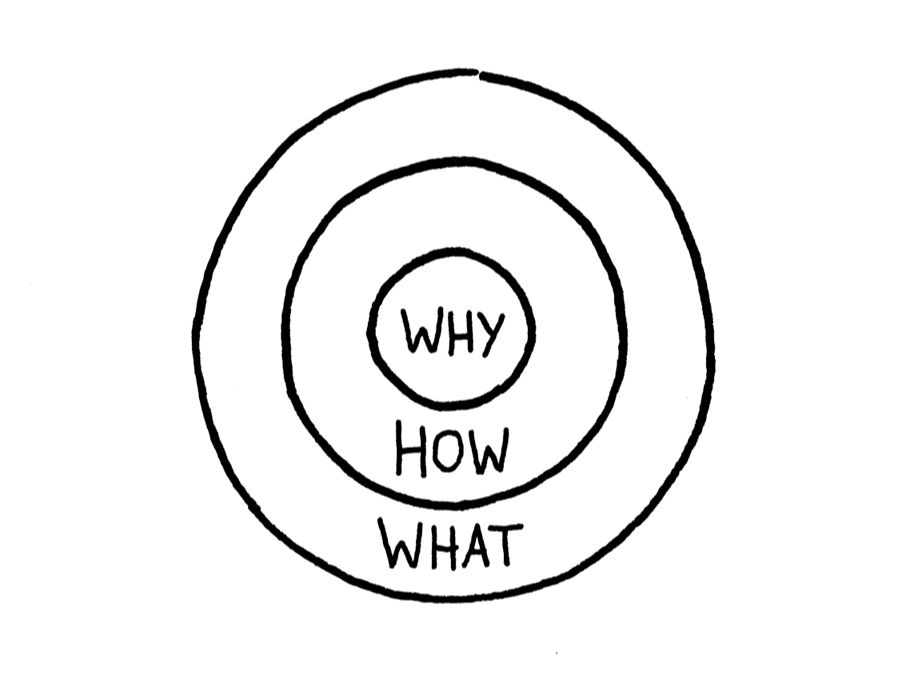
Feb 10, 2015 | Leadership
I recently completed some forecasting and goal setting for my business. As I went through this process, I pulled from several resources that inspire and motivate me, a favorite of which is Simon Sinek’s “Start With WHY.” He expresses his message through what he calls The Golden Circle:

His premise is that you must begin with your WHY, and from there figure out your HOW and WHAT. When Sinek studied successful leaders, he found a common denominator – they inspire through a clearly and passionately articulated WHY. They hold their WHY front and center – like a North Star – to guide their WHAT and HOW. Everything emerges from the core WHY, or belief. HOWs are the actions they take to realize that belief. And WHATs are the results of those actions.
I’ve known about Sinek’s philosophy for a while, but I find even greater meaning in it now – not only for my own personal and business reflection, but also for my clients.
According to this line of thought, most every person and organization knows WHAT they do. That’s usually pretty clear. Some know HOW they do it. But very few know WHY they do WHAT they do. Or at least they don’t stop to think about it or articulate it frequently and consistently.
By WHY, Sinek doesn’t mean ‘to earn revenue,’ but rather, he’s referring to your purpose, your cause, your belief. Sinek asks, “WHAT makes you get out of bed in the morning? WHY do you care? And WHY should others care?” Think of it as communicating from the inside out.
Think for a moment – We busily go about our day-to-day. We take on roles, assignments, projects, and business…and before long we’ve amassed this huge volume of ‘stuff’ without pausing to think about WHY we’re doing it. Even if we know our WHY, we can fail to consciously use it as our lens or filter for making decisions.
As I went through my own reflection, I see room for getting clearer with my own “WHY” and doing a better job of sharing my story.
A theme for me over my life is that I’m a self-starter and risk taker. I grew up in an entrepreneurial family with my parents owning two businesses. My siblings and I were involved in those businesses where there was no task too great or small; we all pitched in to get it done. And if we didn’t know how to do it, we figured it out. Failures were acknowledged as just one step closer to succeeding.
When I finished college, my first jobs were new positions where I was responsible for creating the role. Later on, I set my vision and sites for what I wanted and set out to achieve it, including starting my own business. Through it all, I didn’t have all the information, the guidelines were ambiguous, and I needed to perform and produce results fast. I quite like this messiness – stepping into the unknown, bringing order to chaos, and charting a course where there isn’t one.
This pattern and energy shapes my WHY – To help people know WHAT they want, find their courage, step forward, and take risks. This is the path to which my life and my work is devoted.
Sinek offers, “People don’t buy WHAT you do. They buy WHY you do it. People don’t buy WHAT you sell. They buy WHAT you believe. And people follow you not because they have to, not because they are paid to, but because they want to.”
This concept comes alive every day in business:
- Strategy Development: For an organization to develop its goals, strategies, and tactics, it must first be crystal clear on its WHY, often presented most succinct in a well-crafted vision and mission. As Sinek offers, “It’s not just WHAT or HOW you do things that matters; what matters more is that your WHAT and HOW is consistent with your WHY.” With a WHY clearly stated in an organization, anyone within the organization can make a decision as clearly and as accurately as the top leader.
- Sustainability Planning: The products and services offered by many organizations are broad and complex. It’s important to critically and regularly examine these lines of business and ask, “WHY do we do this,” looking at both mission impact and financial return to gauge long-term sustainability. Yet, we can get so caught up in the day-to-day, that our WHAT mutates into a complex web without a clear connection to vision and mission, and with limited (or lost) return on investment.
- Succession Planning and Leadership Transitions: Sinek concludes that top executives are successful in great part because they inspire and embody what they believe. When the person who personifies the WHY departs without clearly articulating WHY the company was founded in the first place, they leave no clear cause for their successor to lead. “Successful succession is more than selecting someone with an appropriate skill set – it’s about finding someone who is in lockstep with the original cause around which the business was founded. Great 2nd and 3rd CEOs don’t take the helm to implement their own vision of the future; they pick up the original banner and lead the company into the next generation.”
I encourage you to get to your WHY. It yields greater confidence than ‘I think it’s right.’ It’s more scalable than ‘I feel it’s right.’ When you know your WHY, the highest level of assurance you can offer is, ‘I know it’s right.’
_______
Sinek, S. (2009). Start with why: how great leaders inspire everyone to take action. New York: Penguin Group.
 About Jeanie Duncan: Jeanie is President of Raven Consulting Group, a business she founded that focuses on organizational change and leadership development in the nonprofit sector. She is a senior consultant for Raffa, a national firm working with nonprofit clients to lead efforts in sustainability and succession planning, executive transition and search. Additionally, Jeanie serves as adjunct faculty for the Center for Creative Leadership, a top-ranked, global provider of executive leadership education.
About Jeanie Duncan: Jeanie is President of Raven Consulting Group, a business she founded that focuses on organizational change and leadership development in the nonprofit sector. She is a senior consultant for Raffa, a national firm working with nonprofit clients to lead efforts in sustainability and succession planning, executive transition and search. Additionally, Jeanie serves as adjunct faculty for the Center for Creative Leadership, a top-ranked, global provider of executive leadership education.

Oct 14, 2014 | Coaching, Intention, Leadership

Some consider visioning to be a fluff exercise rather than an effective personal or business development strategy. After all, in both our personal and business lives, we spend the majority of our time working ‘in it’ rather than ‘on it.’ However, dedicating time to thinking about the future can be a critical investment that reaps big rewards. How do I know? I have proven it for myself and and experienced it with my clients time and time again. In fact, I have found that visioning is 100% smart business practice, helping organizations and individuals who lead them chart the course, set goals, measure progress, and learn from mistakes – all of which directly impact the bottom line.
Five years ago, I gave myself a gift: a 12-month sabbatical. I had recently left a top leadership post as an arts administrator, knowing that I had completed what I set out to do for the organization. But I didn’t quite know what would come next. I needed a little “white space” between completing a very consuming role and beginning my next venture – a little time off to engage in activities that helped me think, discover, and refill my creative well.
One day while reading The Law of Attraction by Esther and Jerry Hicks, I came across a visioning exercise called the “creative workshop.” The concept is to spend about 20 minutes each day giving thought to what you want with great clarity, describing and refining a fulfilling picture of yourself – and the life you want to live. (The idea, of course, is that you attract and create that on which you focus.)
Ultimately, that exercise led me to create a two-year vision of the most full, enriching, and satisfying life I could imagine. I then laid out specific actions I’d take to guide me toward my longer-term vision. After all, what good is a vision without a plan to get there?
What I thought initially was a simple (fluffy) exercise ended up having a profound effect. Who knew?! It was as if I had sprinkled fairy dust or Miracle Gro® on my life. Each day, I’d re-read and think about my vision and action plan. The phone started to ring, emails arrived, and certain people would simply appear in my path – everywhere from the grocery check-out line to the board room. As if I were a magnet, resources steadily came, each of which had a part to play in helping me fulfill my vision.
That was years ago. And recently, I decided to repeat this “workshop” again for myself, and I am having a similar experience – only this time, my vision seems to have expanded. And once again, I can sense the amazing personal growth beginning to happen.
“We should change our perspective from ‘I’ll believe it when I see it’ to ‘I’ll see it when I believe it.'” – Chuck Duncan
As individuals, we give so much thought and energy to our work, our co-workers, and to our family and friends that we often forget to invest in ourselves. I observed a sign on a colleague’s desk recently that read, “Me First.” While at first this might seem amusing or even appear egocentric, all of us have to remember that if we don’t first focus on ourselves, we have less to give others.
The same thing happens with organizations – visioning is often put off or lost altogether, with a team’s time and effort immersed in the day-to-day details and priorities. Yet such future-thinking exercises don’t have to be daunting undertakings; they can be incorporated into regular staff or board meetings or be integrated into a periodic planning process. I’ve used a version of this visioning exercise with clients in strategy development, sustainability planning, leadership transitions, and coaching. What I’ve found is that individuals and businesses who roll up their sleeves and take action to do it get great results and rewards.
Visioning, when accompanied by smart planning and consistent focus, can yield true transformation for you and for the organizations you work to improve. Getting started is easier than you think!
- Set aside some uninterrupted time. I suggest an hour, but a few sessions at 20 minutes each also can be effective.
- Pick a point in the future – it can be weeks, months, or years.
- Imagine a life (or business) that is vibrant and fulfilling beyond your greatest expectations.
- Give yourself permission without boundaries to dream and create.
- Describe what you’re imagining in specific, vivid detail.
- Then create an action plan to help you get there.
It may not come easily at first, but with a little time spent – perhaps over a few days/sessions – clarity and details are likely to take shape.
Once the intention is set, give attention to your new vision and plan – and enjoy what begins to manifest itself.
“You get what you think about, whether you want it or not.”
– Jerry Hicks
photo credit: Ross Manges Photography via photopin cc

Jul 29, 2014 | Strategy
I’m struggling with my ability to focus today. As in – ‘there are so many priorities, and they all seem like they’re #1.’ Ever experience this challenge?
 When I find myself in this place, the best thing I can do is sort the priorities. If they’re all #1, I find a way to divide them 1A, 1B, 1C. Even when I think they’re the same level of priority and urgency, this helps me differentiate to some degree. This way, I take the 20-headed beast down to 5 heads, focusing now on the top 5 things I must accomplish – in an hour, a day, or a week. Yes, the other 15 things are important too, but they’ll have to take 2nd place for now. Because if there are 20 priorities at once, I know what will happen – I become paralyzed and do nothing, or I fall into a spin and do a little bit with all the items and get little accomplished. In the most busy and pressing times, I do this exercise each day or even twice a day.
When I find myself in this place, the best thing I can do is sort the priorities. If they’re all #1, I find a way to divide them 1A, 1B, 1C. Even when I think they’re the same level of priority and urgency, this helps me differentiate to some degree. This way, I take the 20-headed beast down to 5 heads, focusing now on the top 5 things I must accomplish – in an hour, a day, or a week. Yes, the other 15 things are important too, but they’ll have to take 2nd place for now. Because if there are 20 priorities at once, I know what will happen – I become paralyzed and do nothing, or I fall into a spin and do a little bit with all the items and get little accomplished. In the most busy and pressing times, I do this exercise each day or even twice a day.
This place of ‘everything is a priority’ leads us into the trap of pressing harder, faster, and with greater intensity to try and accomplish everything or achieve a particular unrealistic goal or deadline.
I somehow trick myself into thinking that working harder and doing more is what’s needed to get the job done. Intellectually, I can rationalize the truth in this. But, at a deeper level, I realize that intense effort and pace often depletes my energy, can adversely impact my output, and removes the joy from my work.
To help combat this tendency, I have adopted some practices I find beneficial and that have helped me most:
- Spend the first hour of the day setting priorities and getting organized. It’s easy to launch into the day reacting to the urgent – the rain of emails, interruptions from co-workers, and the barrage of phone calls – rather than advancing the important. I like to get an early start to the day and establish priorities. I begin with the question: “What are the three most important things I need to accomplish today to advance my key goals?” Everything else is a “nice to have.” These three daily priorities all roll up to support my weekly, monthly, and quarterly goals.
- Focus on the important tasks first. Once I frame my day in the first hour, I immediately set out to accomplish the top three priorities before distractions have a chance to pull me away. If I can’t take care of them all, I’ll make an appointment on my calendar to return to it later in the day.
- Single-Task. When I’m doing too much, I’m constantly switching from one task to another, experiencing multiple interruptions and distractions. Despite our culture’s demand to multi-task, resist the temptation, clear away distractions, and give attention to the single matter that is most important.
- Eliminate non-essential commitments. Examine your day or week and ask yourself: “What can I eliminate or delegate? Is that task, meeting, or luncheon something that I absolutely must do? How does it advance my strategic goals?” I try and say no to any request that distracts me from focusing on what’s most important. I think of it as focusing on my highest and best use.
- Step away and take a break. We all have those occasions when work calls for added effort. But more often than not, simply stepping away and taking a break – like going for a run or having lunch in a park – can infuse new energy, bring fresh perspective and new ideas, and actually enhance productivity.
- Ask key questions. Another tactic I find helpful is pausing to ask a few critical questions to help me determine priorities or my approach as I begin a particular project or task. It’s an important skill for anyone focused on improving performance, and it can help filter through all the distractions and get to the one thing that will deliver the result. For example:
- How important is this?
- What do I want?
- Why?
- How will I know when I achieve it?
- What can I do to achieve that outcome?
- What can I learn from others who have gone before me?
- What do I bring from prior experiences that can help inform my present situation?
Challenge yourself this week to do less, focus on what’s most important and will deliver the greatest impact, and discover deeper meaning and success in your work. Notice what happens!
“Don’t mistake activity with achievement.” ~ John Wooden
Jeanie is President of Raven Consulting Group, a business she founded that focuses on organizational change and leadership development in the nonprofit sector. She is a senior consultant for Raffa PC (formerly TransitionGuides), a national firm working with nonprofit clients to lead efforts in sustainability and succession planning, executive transition and search. Additionally, Jeanie serves as adjunct faculty for the Center for Creative Leadership, a top-ranked, global provider of executive leadership education.
photo credit: modenadude via photopin cc

Nov 10, 2012 | Creativity, Management
 About a month ago, I started putting an appointment on my calendar each week called “Time to Think.” Don’t laugh. Stay with me for three minutes…
About a month ago, I started putting an appointment on my calendar each week called “Time to Think.” Don’t laugh. Stay with me for three minutes…
When do you make time to just think? Devoting dedicated, uninterrupted time to think about your business strategy, debrief learnings about a recent project, or assess progress and refine your plans? Maybe you can relate – I get so wrapped up in my day-to-day and the “doing” of my work, that time to plan and strategize often gets pushed aside.
So I decided to make a weekly two-hour appointment to reflect over the last week and look ahead to the next. I ask myself a series of questions, like: What went well? What can I leverage to produce even greater results? What didn’t go well, and why? What brought me the most joy in my work? And on the contrary, what gave me the biggest headache?
In just four weeks, this “thinking” appointment actually seems to expand time. I thought it would be so hard to dedicate the time and stick with it. I was sure that client projects and priorities would override this new commitment and I’d fall off. And that the anticipated benefit would turn out to be fluff. Not true! I’ve experienced immediate, powerful benefits.
– Before, I never stopped to examine all that I actually accomplish in a week. Probably like you, I move quickly from one thing to the next, and it all blends together. This new commitment has taught me that taking the time to reflect (and also to celebrate the “wins”) is meaningful and has a direct, positive impact on my business and on me personally.
– By simply paying attention, I’m noticing things and becoming more efficient. I’ve outsourced or eliminated tasks and changed the way I prioritize and invest in what matters most. Its as if I have more time and other resources.
– It reminds me that I have the power to choose…to create the life I most want to live. I firmly believe that we create that to which we give thought.
– In my work, I love innovation – experimenting and trying new things, then observing its affect. In doing so, it’s beneficial to reflect on what worked and what didn’t and use those findings to inform future action.
I agree that this isn’t some wild, new idea. But for me, this simple action is yielding some very meaningful results. Give it a try and see what happens. I think it might surprise you!

 About Jeanie Duncan: Jeanie is President of Raven Consulting Group, a business she founded that focuses on organizational change and leadership development in the nonprofit sector. She is a senior consultant for Raffa, a national firm working with nonprofit clients to lead efforts in sustainability and succession planning, executive transition and search. Additionally, Jeanie serves as adjunct faculty for the Center for Creative Leadership, a top-ranked, global provider of executive leadership education.
About Jeanie Duncan: Jeanie is President of Raven Consulting Group, a business she founded that focuses on organizational change and leadership development in the nonprofit sector. She is a senior consultant for Raffa, a national firm working with nonprofit clients to lead efforts in sustainability and succession planning, executive transition and search. Additionally, Jeanie serves as adjunct faculty for the Center for Creative Leadership, a top-ranked, global provider of executive leadership education.





Recent Comments